Here’s a list of the best headphones that don’t leak sound for a top-of-the-line private listening experience! Plus, a handy guide on what features to check.
| Name | Type | Connectivity | Noise Reduction | Price |
|---|---|---|---|---|
| Sennheiser HD 450BT Best Overall | Over-ear | Wireless | Active | BUY |
| JBL LIVE 400BT Strong Runner-Up | On-ear | Wireless | Passive | BUY |
| Skullcandy Sesh Evo Budget Pick #1 | True Wireless In-ear | Wireless | Passive | BUY |
| Sony MDR-7506 Budget Pick #2 | Over-ear | Wired | Passive | BUY |
| Shure SE846 Best Premium | In-ear, neckband | Wireless | Passive | BUY |
| Sony WH-1000XM4 Best Noise Cancellation | Over-ear | Wireless | Active | BUY |
| Shure SRH1540 Best for Studio Recording | Over-ear | Wired | Passive | BUY |
| Bowers & Wilkins PX Best for Casual Listening | Over-ear | Wireless | Active | BUY |
How To Pick the Best Headphones that Don’t Leak Sound
Anyone can have different motivations to look for headphones with no sound leakage. It could be to avoid disturbing others when listening in public, to prevent sound bleed when recording, or simply to enjoy your music in peace.
Whatever your reason is, looking for headphones that don’t leak sound can be challenging. Besides, there’s no straightforward technical spec that says “zero sound leakage”! Most of the time, you’d have to test the headphones yourself.
But what if you can’t, especially if you’re buying online?
Several combinations of factors help headphones maintain their users’ privacy while also maximizing their listening pleasure. Admittedly, some concepts can be confusing, especially to casual buyers.
That’s why we’ve created this nifty Buyer’s Guide to help you decide how to choose the best headphones that don’t leak sounds.

Headphone type
A headphones’ design, fit, and form factor all contribute to how well it can block out ambient sounds, all while keeping your listening experience private. There are several headphone types to choose from, and some are better at handling sound leakage than others.
Earbuds can be categorized into two types, while headphones have four, based on form factor and earcup design.
Types of earbuds:
- Regular earbuds: Simply rest on the ears. They are more common and cheaper.
- In-ear monitors (IEMs): Have elongated ear tips that reach deeper inside the ears.
Types of headphones based on form and fit:
- Over-ear headphones: The earcups fully cover their users’ ears.
- On-ear headphones: The earcups simply rest on top of the users’ ears
Types of headphones based on ear cup design:
- Closed-back: Designed to send sounds in one direction (towards your ears)
- Open-back: Their backs are open for airflow. They can also direct sounds either towards or away from your ears.
In general, IEMs are the best choice for earbuds that don’t leak sound, thanks to how their speakers sit snugly and form a seal on your ear canal. For headphones, closed-back over-ears come out on top thanks to the sound barriers on their ear cups.
Moreover, choosing between IEMs or over-ears is based on your preferences. IEMs can provide portability and ease of use. On the other hand, closed-back over-ear headphones can provide better sound quality due to their larger drivers.
Noise isolation
Also known as passive noise cancellation, noise isolation refers to the headphones’ ability to block ambient noise by combining different physical design elements. This follows the same idea as putting your hands over your ears to avoid hearing outside noise.
Since they’re more expensive and have more advanced tech, many people think that headphones with ANC are always the better choice.
But while ANC is a great option for reducing ambient noise, it isn’t exactly effective when it comes to preventing sound leakage. So, though you won’t hear anything around you, there’s no guarantee that everyone else won’t hear what your headphones are playing as well.
That’s why if you only need headphones that don’t leak sound, passive noise cancellation is more recommended than those with ANC.
Basically, a good passive noise cancellation goes both ways: it blocks the noise from outside from coming in and blocks the headphones’ sound from coming out.
Padding quality
Aside from the headphones’ ear cup enclosure, one thing that also affects sound leakage is your headphones’ padding. After all, the headphones’ ear cup padding is the thing that directly wraps around and covers your ears.
The same goes with your IEMs’ ear tips. In their case, the tips are the ones you plug inside your ear canal.
That’s why your headphones’ sound leakage depends a lot on your padding’s shape, design, and materials.
Moreover, if you prioritize noise isolation, chances are, you can be stuck with headphones that feel warm on the ears in the long run. This can be an issue on breathability, which refers to how well the earcups remain ventilated despite the design. Again, this depends on the padding quality.
Now, whether you go with IEMs or over-ear headphones, the best material that you can use is memory foam. This type of foam is made from polyurethane combined with some chemicals. This combination results in a cushion that molds to your body parts while evenly distributing body weight.
However, memory foam is more expensive than regular foam. Also, they’re not the most breathable option.
Memory foam can retain and absorb body heat, which can accumulate after long listening hours. That’s why, you shouldn’t just settle with any headphones with memory foam padding, but also consider the material that covers them. Try to look for those that complement memory foam well in terms of moldability, while also mitigating the lack of breathability, instead. Considering these, it’s best to go for headphones with memory foam wrapped in fabric or velour ear pads.
Comfort and fit
There’s nothing worse than wearing something uncomfortable for long periods of time. Aside from the irritation, uncomfortable headphones can heavily detract from your audio experience. That’s why comfort should always be at the forefront when buying any kind of headphones, especially for those with no sound leakage.
On the other hand, fit dictates how well a pair of headphones sits snugly on your ears. Aside from helping headphones remain in place, fit also contributes highly to noise isolation. The better the fit, the better the isolation.
There are several factors that contribute to headphones’ comfort and fit. While it’s best to test drive a pair of headphones before purchasing them, that’s not always possible especially if you’re buying online.
In this case, here are the things you can check on the product description instead:
- Weight: Weight can be subjective. Different people perceive the actual weight of the same pair of headphones differently when worn. However, the general rule is to always try to go for headphones below 0.55 lbs.
- Tactile sensation: This refers to how your skin feels and reacts when it comes into contact with your headphones. Synthetic and genuine leather and velour are considered the best materials for this.
- Adjustability: Every user has their own head shape and size. That’s why headphones should provide some degree of customization as part of their features. That way, they won’t feel too loose or too tight. Basically, look for headphones that have an expandable headband and rotating ear cups.
Sound Quality
When talking about sound quality in general, you can always hear audiophiles prefer open-back headphones. This is because this type allows air to flow more freely, leading to a more realistic and wider sound imaging.
However, as mentioned before, open-back headphones should be avoided when looking for headphones that don’t leak sound.
Unfortunately, not many closed-back headphones can produce sound quality as good as their open-back counterparts. That’s why, if you’re looking for headphones with zero sound leakage, you should set your expectations when it comes to sound quality.
Basically, the enclosure on closed-back headphones makes low frequencies louder and boomier. And, while that may sound good for bass heads, this often leads to too much bass that can turn the mids and the highs sound muddy.
The air and sound also won’t have anywhere else to move to besides your ears. This creates a sensation of being in a ‘bubble’ and, ultimately, limits the soundstage/imaging of whatever audio you’re listening to.
The sound quality of closed-back headphones is generally a known fact. But it can change depending on how well your headphones are manufactured.
There are closed-back headphones that come with companion Equalization (EQ) apps, which allow you to tweak the sound profile. These EQ apps allow headphones with a wider frequency range to replicate audio as they were intended to be heard. If you value sound quality, it’s best to look for these features.
8 Best Headphones the Don’t Leak Sound in 2023
Sennheiser HD 450BT

Key features
- Type Of Headphones: Over-ear
- Connectivity: Wireless
- Battery: 30 hours
- Driver Type: Dynamic
- Driver Size: 32 mm.
- Noise Reduction: Active
The Sennheiser HD 450BT stays true to its heritage by covering all the basics you may require from a pair of headphones that don’t leak sounds. Their closed-back design and synthetic leather paddings gently cover the ears to prevent sound from coming in or out. Plus, they’re wireless, so they’re great to bring around!
The HD 450 BT can produce balanced audio that can suit almost anyone’s musical tastes. And though the design does affect the bass, these headphones also come with the Smart Control app so you can adjust the EQ settings.
Moreover, their excellent audio performance is backed up by long battery life. The 30 hours of listening pleasure these provide is nothing to scoff at.
Excellent quality active noise cancellation (ANC) is usually reserved for high-end headphones, but the HD 450BT destroy this stereotype. While there’s a minor perceivable dip in sound quality when ANC is activated, these still sound better than what most headphones offer within their price range.
Overall, the Sennheiser HD 450BT are excellent headphones with no perceivable sound leaks. Just be aware that the built-in microphone is not up to par with the sound quality the headphones deliver. The mic noise reduction isn’t commendable and may require you to say what you need multiple times when on calls. But for their price and performance, they’re all well worth it.
JBL LIVE 400BT
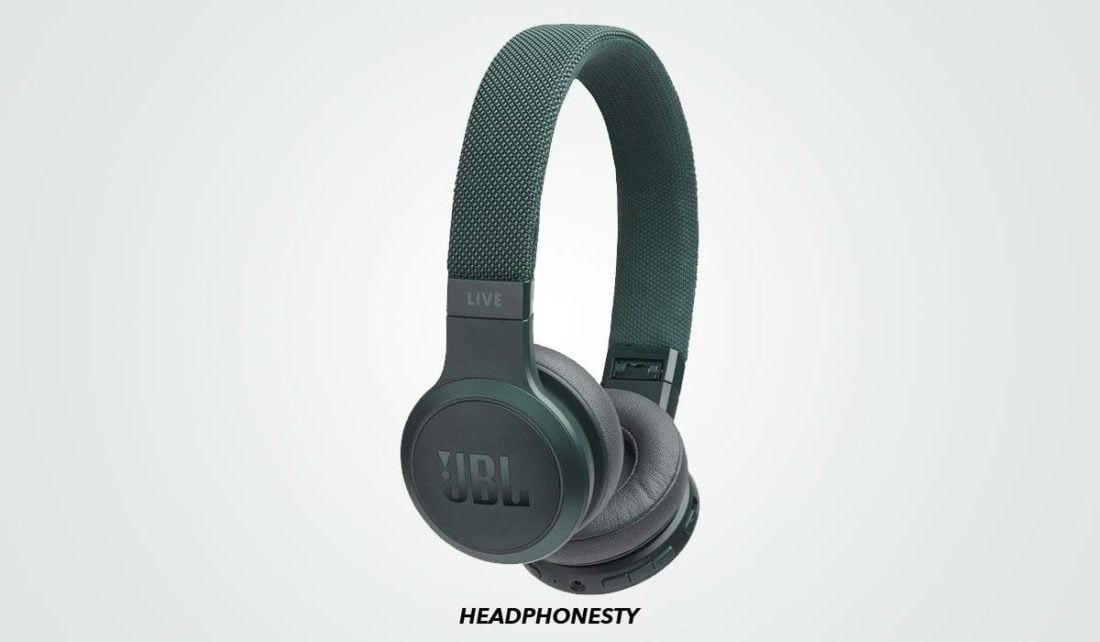
Key features
- Type Of Headphones: On-ear
- Connectivity: Wireless
- Battery: 30 hours
- Driver Type: Dynamic
- Driver Size: 40 mm.
- Noise Reduction: Passive
The JBL LIVE 400 BT are wireless pair of headphones with a solid design and lightweight build. They’re less bulky compared to other headphones within their price range. Plus, they also allow for more breathability, despite the good noise isolation.
However, they are on-ear headphones which means they’re not that good with preventing outside noise from sneaking in. That’s why they rank a tad lower than the Sennheiser HD 450BT.
Despite that, they surprisingly have almost no sound leakage so you can try raising the volume to drown out ambient noise without worrying about disturbing others.
The 40 mm drivers are capable of producing good v-shaped sound. The JBL Live 400 BT have a clear emphasis on the lower end. Yet, the midrange frequencies remain decent and clean. However, the highs can sound bright. And while the instrumentals aren’t affected that much, the vocals can end up sounding harsh.
Luckily, JBL has provided its own app to fix this relative harshness in the vocals. Tweaking the included EQ in the My JBL Headphones app provides some fixes in the higher ranges.
Skullcandy Sesh Evo
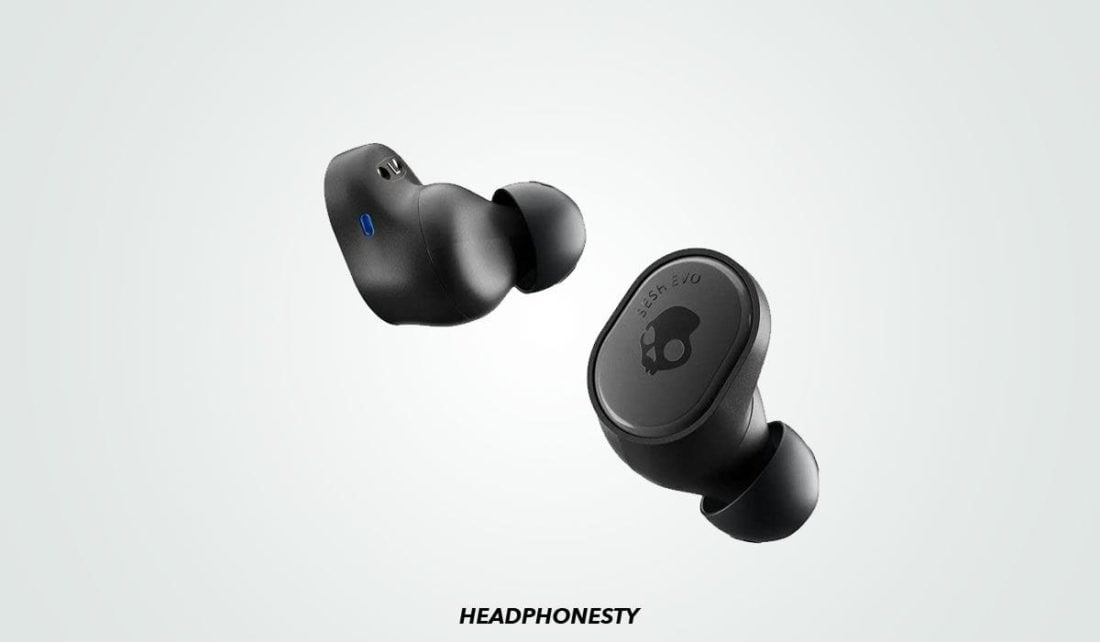
Key features
- Type Of Headphones: True wireless in-ear
- Connectivity: Wireless
- Battery: 5 hours
- Driver Type: Dynamic
- Driver Size: 6 mm
If you’re on a tight budget but still want a pair of headphones with good noise isolation, we recommend the Skullcandy Sesh Evo.
It has a variety of colors to choose from and even comes with three pairs of complementary ear tips in different sizes (small, medium and large) to accommodate different ear types. This selection helps in reducing sound leakage since it can help you find the right-fitting ear tips for you.
These IEMs have rich, boosted bass complemented by crisp highs. In contrast, the middle range is only average at best. Despite that, we’d say the overall sound of these IEM’s are worth noting!
That’s why the Skullcandy Sesh Evo are best used for listening to music, podcasts, and movies. Their bass also makes them highly recommended for people who work out at the gym.
However, the Sesh Evo’s ear tips tend to go deeper in your ears when tapping the multi-function buttons. This may elicit discomfort from some users. Thankfully, the Sesh Evo IEMs are lightweight and breathable to make up for it.
Sony MDR-7506
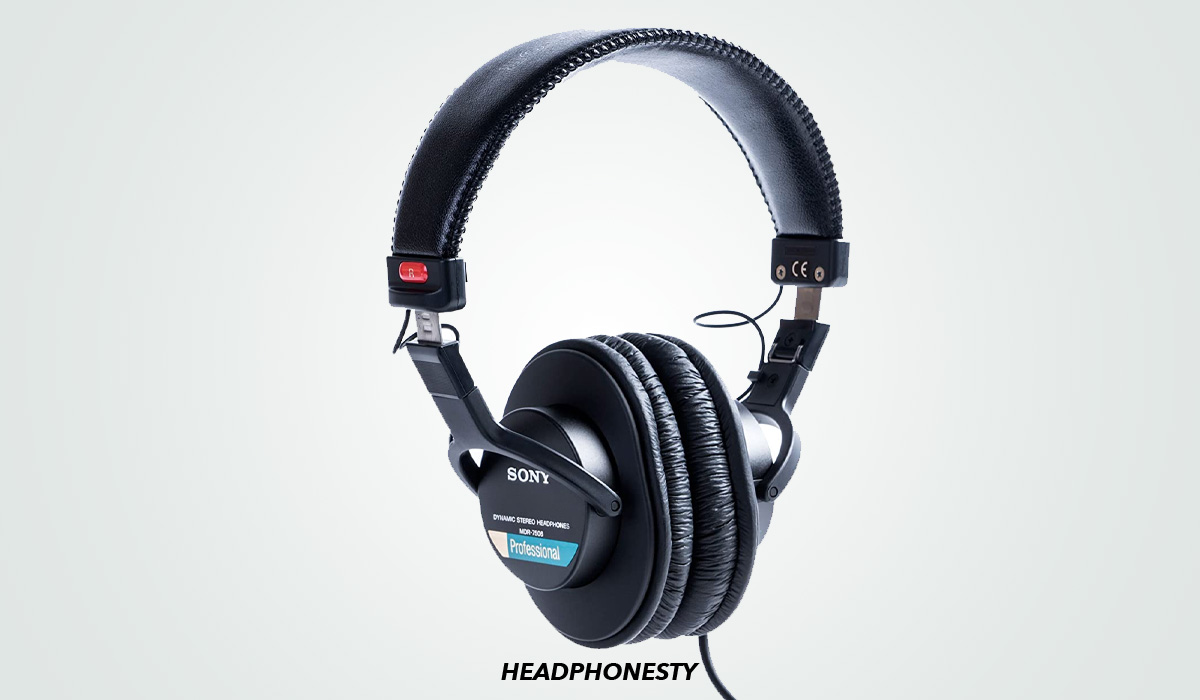
Key features
- Type Of Headphones: over-ear
- Connectivity: Wired
- Battery: Not applicable
- Driver Type: Dynamic
- Driver Size: 40 mm.
- Noise Reduction: Passive
The Sony MDR-7506 are one of the best wired headphones you’ll get at a low price. They are positive proof that affordability doesn’t necessarily equate to a pair of low-performance headphones.
As expected, the frequency range sound balanced. The 40 mm dynamic headphone drivers deliver above average audio no matter what musical genre is played. There’s a slight emphasis on the mids and highs and bass is only middling at best. But this doesn’t detract from the overall sound quality.
Because of the coiled cables, the MDR-7506 are more for at home/studio settings. They are very much recommended for YouTube content creators and Podcasts since they avoid sound bleeds when recording. Budding sound professionals who require an excellent but affordable pair of headphones should also take notice.
While sound performance is good, the tradeoff for the low price is the quality of the materials used. Over time, the faux leather padding can be prone to flaking. The good news is, their parts are easy to replace and the replacements available on the market are still relatively affordable.
The Sony MDR-7506 is a worthy purchase. If you can overlook the relatively minor flaws then you’ll have a good pair of wired headphones for use in home/studios. Sound-wise, these are very much capable of matching their pricier contemporaries.
Shure SE846 BT2
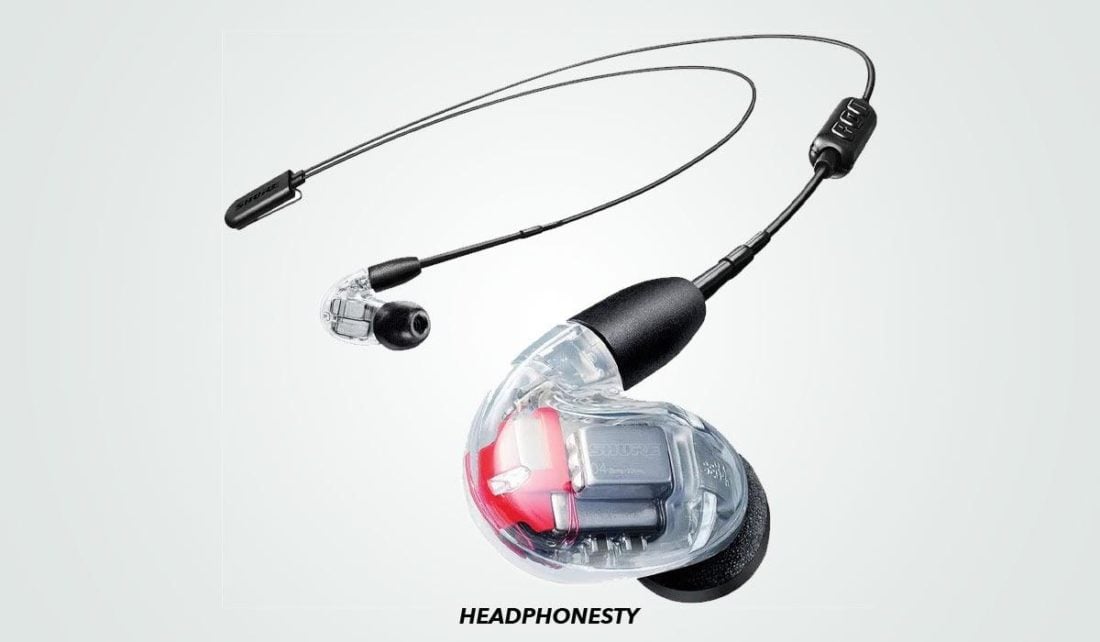
Key features
- Type Of Headphones: In-ear, neckband
- Connectivity: Wireless
- Battery: 9 hours
- Driver Type: 4x balanced armature
- Driver Size: not specified
- Noise Reduction: Passive
Out of the other headphones presented here, the Shure SE846 BT2 are, without a doubt, the most fitting for the title of the Best Premium pair of headphones. And with good reason: they’re so durable especially with a material that has military applications (Kevlar).
The SE846 also have a good audio performance to justify the price. While most IEMs struggle with bass, Shure SE846’ subbass response is excellent while the midbass doesn’t disappoint. It can bring out the full bass when needed without overpowering the other frequencies.
Their midrange frequencies bring out more detail in the songs while keeping the vocals crisp and clear. The highs aren’t bad either, keeping pace with the other frequencies while letting the treble range shine.
Considering that the SE846 is a pair of IEMs, it can block out most external noises while preventing sound leaks more effectively than some closed-ear headphones. They also come with a wide variety of ear tip types and sizes so you can enjoy no audible sound leakage even on higher volumes.
The Shure SE846 are great IEMs for everyday use. They are recommended for people who frequently commute and require privacy with their audio. If cost isn’t an issue, then you’ll get a lot of mileage from the SE846.
Sony WH-1000XM4
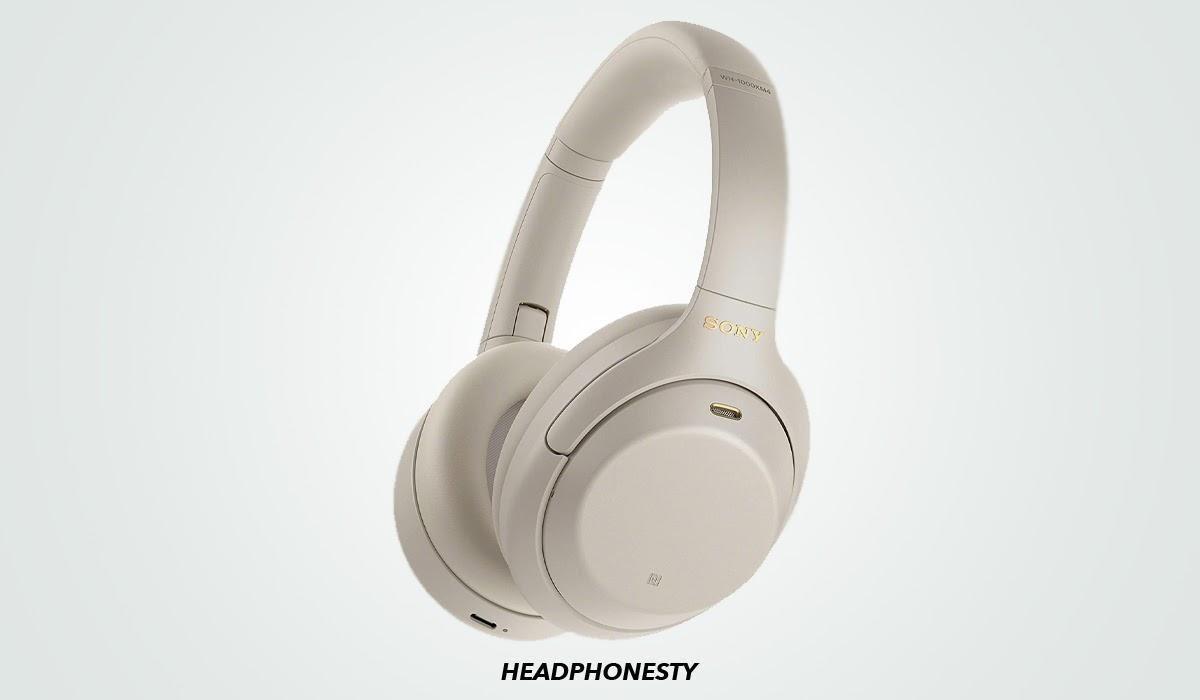
Key features
- Type Of Headphones: Over-ear
- Connectivity: Wireless
- Battery: 30 hours
- Driver Type: Dynamic
- Driver Size: 40 mm.
- Noise Reduction: Active
If you’re looking for a pair of wireless headphones with the best ANC capabilities, then the Sony WH-1000XM4 are your best choice. These headphones have a great combination of both active and passive noise cancellation. So, they effectively block outside noise from coming in, while keeping the headphones’ sound from getting out.
Aside from Bluetooth 5.0, the WH-1000XM4 also support Bluetooth Multipoint. This feature allows the listeners to connect to multiple Bluetooth devices simultaneously. The auto pause ability is also a nice addition. It immediately detects if the headphones are removed.
The list of features continue in the sound department as well. These headphones can reproduce rich, detailed sound, while providing a broad sound stage. There’s a very slight emphasis on the lower frequencies when the bass kicks in. But it doesn’t muddy up the mids or highs. Overall, the sound reproduction stays faithful to the original.
The Sony WH-1000XM4 are perfect for long commutes and air travel. Just be aware that its Bluetooth Multipoint capabilities require the proper codec (AAC Bluetooth codec) on the source device to work properly.
Shure SRH1540
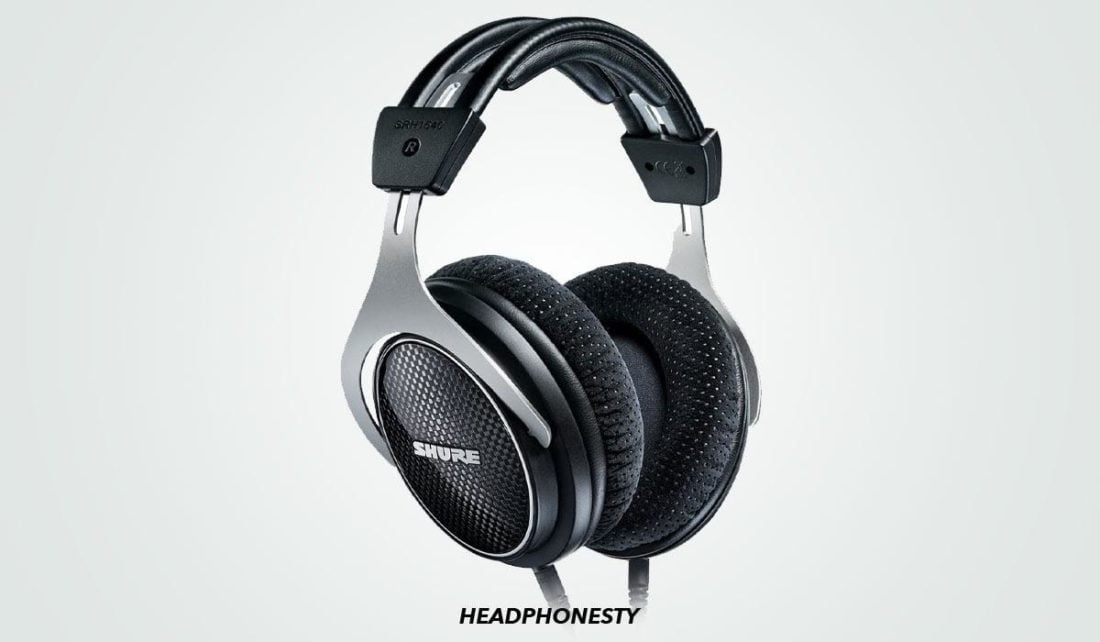
Key features
- Type Of Headphones: Over-ear
- Connectivity: Wired
- Battery: Not applicable
- Driver Type: Dynamic
- Driver Size: 40 mm.
- Noise Reduction: Passive
There’s a good reason why the Shure SRH1540 are ranked as Best for Studio Recording. Their noise isolation, while passive, is unmatched by any other within its market range. The design, materials, and fit also combine to provide a pair of headphones with zero sound leaks.
The first thing you’ll notice is that SRH1540’s ear cups are big but not bulky. This helps create a good seal, even for people with large ears.
Shure SRH1540’s overall build is also commendable, both in looks and performance. The ear pads are actually wrapped Alcantara – the same material used in most car seats, which make them both durable and comfortable.
Moreover, the SRH1540 can produce a decent but balanced sound — one that’s good for both instrumentals and vocals. The bass has some punch to it, but not enough to overpower the other frequencies. The SRH1540 shines best in neutral listening.
Sound professionals and musicians looking for the best headphones that don’t leak sound would definitely benefit from Shure SRH1540’s level of noise isolation. The only downside is the lack of portability. Even when folded, the Shure SRH1540 is still a bit cumbersome to bring around.
Bowers & Wilkins PX
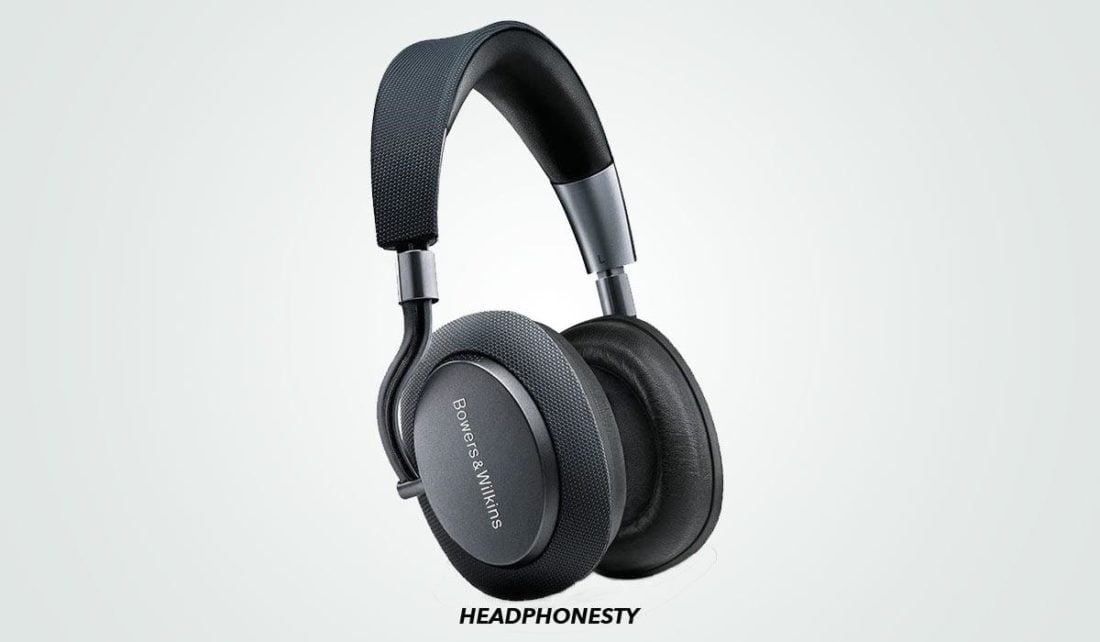
Key features
- Type Of Headphones: Over-ear
- Connectivity: Wireless
- Battery: 22 hours
- Driver Type: Dynamic
- Driver Size: 43.6 mm.
- Noise Reduction: Active
The Bowers & Wilkins PX are actually B&W’s first attempt at producing wireless headphones, which certainly made an impact. Their solid build is complemented by lightweight materials, making them more portable, unlike most over-ear headphones.
The B&W PX cover a lot of bases to provide the best user experience for the users. The B&W Headphone app allows some degree of customization with its ANC. With this app, you can choose to allow some ambient noise to pass through depending on your needs or tastes.
These also have a proximity sensor, which automatically pauses the music when taking the B&W PX off.
The B&W PX even go a little further with this concept: lifting one earcup just as you would when talking to someone is enough to initiate a music pause. Taking it off for several minutes turn these to power-saving standby mode. And, wearing them again will cause them to restart and continue where you left off. This feature gives more mileage out of the PX’s 22 hours of playtime.
An abundance of features, portability, and excellent ANC all add up to a worthy purchase. We can say that the only downside is that the B&W PX that are a bit heavy (11.8 oz. or roughly a third of a kilo). The weight may cause some discomfort with prolonged use but not enough to dissuade the discerning tastes of audiophiles, casual listeners, and everyone in between.
actually I’ve found that the Sony WH-1000XM4’s have a lot of sound leakage. at 100% volume they basically qualify as speakers. At 50% you can clearly hear the song i’m playing it’s ridiculous for the price.
Totally agree with this – bought a pair and returning, for the price they should be way better. May as well have a speaker.